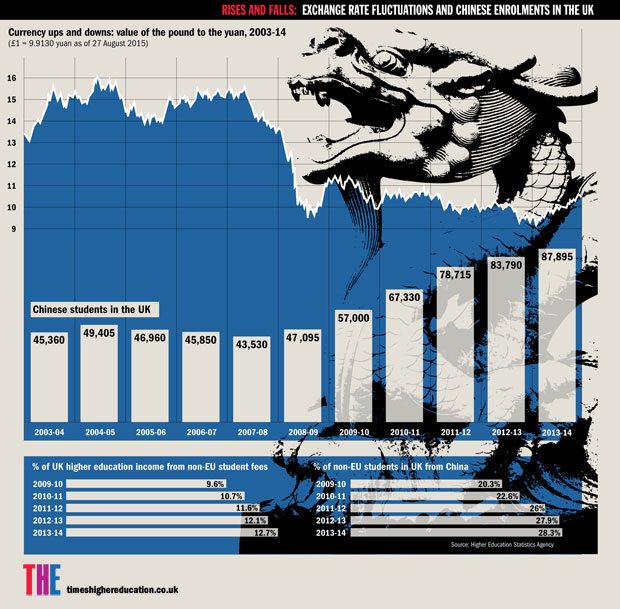Imagine the scenario: an increasingly prosperous Asian country, which sends more students than any other nation to UK universities, is suddenly hit by a stock market collapse, a currency devaluation and a deep recession. Students are unable to afford foreign study, leaving academic departments across the UK with a financial black hole.
This is not a fearful projection of what may happen in China after the recent chaos on the stock markets and the surprise devaluation of the yuan in early August. It really happened: the year was 1997, but the country was Malaysia. In that year, the Asian financial crisis wiped almost half the value off the Malaysian ringgit, and the country entered a deep recession.
The consequences for UK universities were grave. In 1996-97, more than 18,000 students came from Malaysia, making it by far the biggest exporter of international students to the UK. Yet by 1999-2000, this had collapsed to barely over 10,000 students. Numbers have still not recovered to their pre-financial crisis levels.
“The sudden reduction we all felt in students from Southeast Asia caused real turbulence in the sector,” recalled Vincenzo Raimo, pro vice-chancellor (global engagement) at the University of Reading.
But he warned: “We’re in a much more dangerous position today.”
Over the past decade, financial reliance on international students, and specifically those from China, has ballooned.
In 2013-14, tuition fee income from students from outside the European Union was almost £4 billion, more than £1 in £8. Of this, Chinese students accounted for about £1.1 billion (assuming that their fees were similar to those paid by other international students).
Worryingly for universities, the boom in Chinese students could simply rest on an unusually good exchange rate, at least in part. From 2003 to 2008, the number of Chinese students was roughly flat. They began arriving in increasing numbers only after the pound lost about a third of its value in 2008, making study in the UK a much more affordable option for Chinese families.
It is unclear exactly where the value of the yuan will end up. But the modest devaluation in mid-August was seen by some as the start of a longer trend towards pre-2008 exchange rates designed to boost exports and revive China’s slowing economy. Recently Bloomberg reported that Chinese economic agencies are already assuming a devaluation of 20 per cent against the dollar by the end of 2016.
‘Peak may be just around the corner’
In addition to currency dangers, a weakening economy, fewer youngsters and better domestic universities imperil this key source of students. “These issues mean that the peak of China’s outbound study trend may be just around the corner,” suggests Matt Durnin, head of research in China for the British Council.
“Regardless of how China’s economic growth fluctuates over the next few years, we don’t expect that the outbound study surge of the past decade will continue much longer,” he said.
Even if all Chinese students deserted the UK overnight, universities would lose only 3 to 4 per cent of their income. Yet this overall figure disguises the concentration of Chinese students on certain courses, which could become especially vulnerable if numbers drop. A report released in February by the Higher Education Funding Council for England warned of an “over-reliance” on Chinese students at postgraduate level. On full-time taught master’s courses in England, they make up a quarter of those enrolled – almost as many as British students.
“The problem with the rapid growth in China’s outbound student mobility over the past decade is that it has made many universities complacent about recruitment,” argued Mr Durnin.
A mix of knowledge and naivety
US universities are likely to be less vulnerable than their UK counterparts to any Chinese slowdown because proportionally they recruit far fewer foreign students. International students represent just 4 per cent of the total higher education population. And due to their tuition fee system, Chinese students are usually no more financially lucrative than out-of-state American students.
Australia is a different matter. Almost 8 per cent of students there are Chinese, more than double the figure in the UK.
Exposure to international markets has also changed what it takes to run a university. About half of UK institutions now have an international pro-vice chancellor, estimated Neil Kemp, a consultant on international education.
Although there is still some “naivety” in universities about international recruitment – including wildly high targets set by vice-chancellors – Dr Kemp said that senior managers’ knowledge of global economic trends is now “excellent”, and far better than it was a decade ago, something that may help as the UK navigates any coming recruitment storms triggered by the China crisis.
POSTSCRIPT:
Print headline: Does China’s crash signal crisis for UK?
Register to continue
Why register?
- Registration is free and only takes a moment
- Once registered, you can read 3 articles a month
- Sign up for our newsletter
Subscribe
Or subscribe for unlimited access to:
- Unlimited access to news, views, insights & reviews
- Digital editions
- Digital access to THE’s university and college rankings analysis
Already registered or a current subscriber? Login










